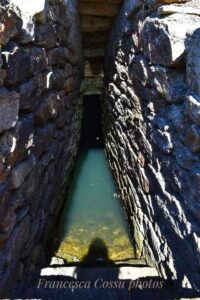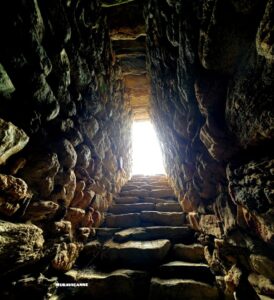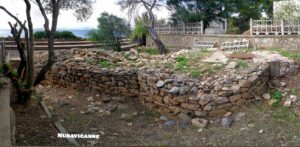The historian Dionigi Panedda (Bitti 1916 – Olbia 1989), in some passages of the book “Olbia e il suo volto,” proposed some considerations on the sacred wells, particularly comparing the structure of the well of “Milis” in Golfo Aranci with that of the well of “Sa Testa” in Olbia:
“The sacred wells, or well temples, were places of worship, where the Nuragic people venerated the water from the springs, which they believed to be the abode of the god or the god of the springs. The well temple of ‘Sa Testa’ is located a short distance from the restaurant ‘Il pozzo sacro,’ on the coastal road that leads from Olbia to Golfo Aranci. Its fairly good state of preservation is due to the fact that the monument was discovered accidentally only in the 1930s, after being buried for centuries under fill material. In its architectural structure, four parts can be recognized: a circular courtyard, where, presumably, the faithful gathered during the sacred rites; a vestibule or pronaos, in which, on the right side, the altar was placed, now lost; a staircase of 17 steps, with a straight ramp, covered by beams in progressive descent; and, at the bottom of the staircase, a ‘tholos’ chamber, from whose floor the spring water flows. The sacred well of ‘Sa Testa’ seems to belong to the oldest group of well temples: those built with rows of uncut stones, most of which are roughly shaped into parallelepipeds characteristic of ‘subquadrata’ work.” As for a more precise chronology of the monument, it appears sufficiently indicated by its technical characteristics: absence of megalithism in the stones used; harmonious articulation of the environments that, outside, connect with the succession of always sinuous lines, while inside there is a multilinear movement of walls. All of this denotes a more evolved period of nuragic architecture, which, later on, even in the ‘tholos’ temples, will reach the perfection of the ‘isodomic work’… (omissis)…
As for a more precise chronology of the monument, it appears sufficiently indicated by its technical characteristics: absence of megalithism in the stones used; harmonious articulation of the environments that, outside, connect with the succession of always sinuous lines, while inside there is a multilinear movement of walls. All of this denotes a more evolved period of nuragic architecture, which, later on, even in the ‘tholos’ temples, will reach the perfection of the ‘isodomic work’… (omissis)… “The well temple of Golfaranci is located in that part of the Gulfaranci railway station where the heliotherapy colony for the children of railway workers is situated. Compared to that of ‘Sa Testa’, the well ‘Milis’, as far as the layout is concerned, lacks the circular courtyard and the pronaos. However, the latter – which could not be missing in such a monument – has surely been destroyed.”
“The well temple of Golfaranci is located in that part of the Gulfaranci railway station where the heliotherapy colony for the children of railway workers is situated. Compared to that of ‘Sa Testa’, the well ‘Milis’, as far as the layout is concerned, lacks the circular courtyard and the pronaos. However, the latter – which could not be missing in such a monument – has surely been destroyed.” The current rectangular space that stands in its place is a later construction that became necessary to protect access to the well. The circular courtyard, on the other hand –not always present in sacred wells– may have been in that of ‘Milis’, and could have been destroyed by the excavations carried out in that area in the second half of the last century, when the railway station was built. As for the proportions, the well ‘Milis’ has more monumental dimensions than those of the well temple of ‘Sa Testa’.
The current rectangular space that stands in its place is a later construction that became necessary to protect access to the well. The circular courtyard, on the other hand –not always present in sacred wells– may have been in that of ‘Milis’, and could have been destroyed by the excavations carried out in that area in the second half of the last century, when the railway station was built. As for the proportions, the well ‘Milis’ has more monumental dimensions than those of the well temple of ‘Sa Testa’. More monumental, for example, both in the staircase which originally had 40 steps; and in the ‘a tholos’ chamber, which has an overall height greater than 9 m. As for the technical structure, it doesn’t seem to me that there is a substantial difference between the two monuments, especially in the walls that flank the staircase. But also the parallelepipeds of the local stone, which we see here used, are worked with a mallet, thus giving rise to the ‘subquadrata’ work.
More monumental, for example, both in the staircase which originally had 40 steps; and in the ‘a tholos’ chamber, which has an overall height greater than 9 m. As for the technical structure, it doesn’t seem to me that there is a substantial difference between the two monuments, especially in the walls that flank the staircase. But also the parallelepipeds of the local stone, which we see here used, are worked with a mallet, thus giving rise to the ‘subquadrata’ work. The greater refinement that emerges from the ‘Milis’ well is, in my opinion, attributable to the different nature of the stone used for the construction of the monument. As for the chronology of the well temple of Golfaranci, I believe that it is largely contemporary to that of ‘Sa Testa’. Based on the finds collected in both wells, it seems that the latter was not used in the period following the nuragic age, unlike the Pozzo Milis, whose use extends into the Roman age.
The greater refinement that emerges from the ‘Milis’ well is, in my opinion, attributable to the different nature of the stone used for the construction of the monument. As for the chronology of the well temple of Golfaranci, I believe that it is largely contemporary to that of ‘Sa Testa’. Based on the finds collected in both wells, it seems that the latter was not used in the period following the nuragic age, unlike the Pozzo Milis, whose use extends into the Roman age. The photos of the sacred wells Sa Testa in Olbia and Milis in Golfo Aranci are respectively by Francesca Cossu and Nuraviganne.
The photos of the sacred wells Sa Testa in Olbia and Milis in Golfo Aranci are respectively by Francesca Cossu and Nuraviganne.

